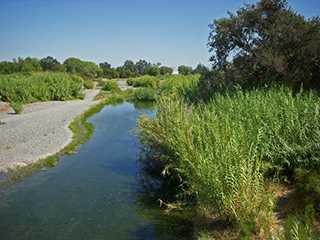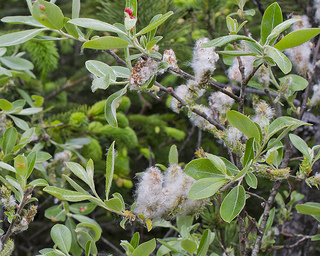 Arundo donax invading a riparian zone. Photo © Neal Kramer.
Arundo donax invading a riparian zone. Photo © Neal Kramer.
Please don’t plant giant reed (Arundo donax). Giant reed is a perennial reed that grows three to ten meters tall in cane-like clumps. Giant reed spreads horizontally from rootstock in the soil, easily forming large colonies many meters wide. Its stems are tough and hollow, resembling bamboo, and it is often confused with bamboo or corn. Giant reed is considered indigenous to the Mediterranean Basin, but it was likely introduced to Europe from India.
Giant reed grows in riparian areas, and in regions where it is invasive, it replaces native riparian trees and grasses, altering the ecology of riparian areas. It spreads easily and is difficult to control, and does not supply the same habitat type as the plants it replaces. It was introduced in Southern California around the Los Angeles River in the early 1800s, where it was cultivated for roofing material and musical instrument production. It is still in cultivation today and often used in gardens for erosion control. Invasive populations in the wild likely established from plants that escaped cultivation. Most infestations of giant reed must be controlled with chemical treatment. In order for mechanical treatment to be effective, an infestation must be caught very early, when plants are new and shorter than two meters.
Native Alternative
 Salix hookeriana, one of many California willow species. CDFW photo by Jeb Bjerke.
Salix hookeriana, one of many California willow species. CDFW photo by Jeb Bjerke.
Willows (Salix spp.)
Many willows may be planted successfully in riparian or other wet areas and may form multi-trunked trees or shrubs. There are many species of native California willows to choose from that will not produce the negative environmental consequences that may result from planting giant reed. Some willow species can grow quickly, similar to giant reed, to create screens or garden structures, and willows may also be severely cut back to control growth and to shape them as needed.
Updated 01/16/2014